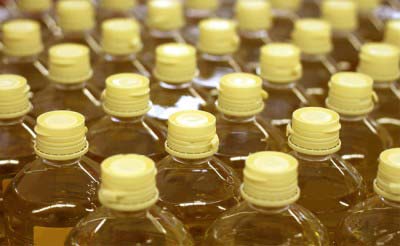
India's veg oil imports forecast to surge 60% to $15 billion this year: ASSOCHAM
The Dollar Business Bureau | @TheDollarBiz  The juggernaut of India’s veg oil imports, which started rolling in the mid-nineties following import relaxations and economic reforms, is all set to grow to mammoth proportions this year. A new report by the Associated Chambers of Commerce & Industry of India (ASSOCHAM) says that India’s spending on veg oil imports is expected to reach a record high of $15 billion in FY2014-15. This is over 60% more than what India spent in FY2013-14 (around $9.3 billion) and about 3% of India’s total imports last year. According to the report, India’s imports of veg or edible oils in the first five months of this fiscal year are already up over 53% y-o-y in terms of value, and the subsequent festive months are going to drive it up further. As of October 2014, India has imported more than half of its domestic edible oil requirements, adds the ASSOCHAM paper. Veg oil consumption is growing faster than growth in domestic production in India. The share of veg oil imports stood at around 15% of total edible oil consumption in India in 1995-96 but it surged to around 53% in 2009-10 and is expected to increase to over 60% this year. This means that three out of five veg oil bottles that an Indian buys contains imported oil. While the reliance on imports have grown steadily and sharply this year, India’s vulnerability to external price shocks has worsened. ASSOCHAM says that the stock-to-use ratios are alarmingly low. “The industry stocking norms of the seasonal crops indicate that about 20% of the production should be in the form of stocks to meet the ongoing demand until arrival of the next crop in the market. The stock-to-use ratios of the edible oils in India remained at less than half of the required levels indicating how much their prices are susceptible to volatility,” says D.S. Rawat, Secretary General, ASSOCHAM. There are various factors at play here, and unfavourable weather conditions is one of those. Domestic production from the khariff oil crop is expected to decline about 10% this year due to the El Nino effect. According to the ASSOCHAM Agri Research Wing, production of the major three Khariff oil seeds -- sunflower, groundnut and soyabean – is expected to decline respectively by 35%, 31% and 1%. However, the trade policies in India and veg oil producing countries play a bigger role, experts told The Dollar Business. According to the Solvent Exporters Association of India (SEAI), Indonesia and Malaysia have removed export duty on veg oils to offload burgeoning stocks. This is likely to push higher India’s imports of crude veg oils which stood at around 8.95 million tonnes in November 2013 – September 2014, up about 22% from the same period last year. SEAI says that increasing the import duty on crude veg oil is important to protect domestic farmers and prevent oil crop acreage from shrinking next year. Meanwhile, the inverted duty structure in India encourages veg oil imports and discourages imports of oilseeds. Earlier this year, the Finance Minister removed the 7.5% import duty on industrial grade crude veg oils, but this helps manufacturers of soaps and not the veg oil industry. Earlier, Kishore Tanna, Chairman, Indian Oilseeds and Produce Export Promotion Council (IOPEPC), told The Dollar Business that there is a need to encourage oilseed imports instead of depending heavily on crude veg oil imports. Tanna says, “At present while the edible crude and refined oils are allowed for import only at 2.5 and 10% duty respectively, the import of oilseeds attract much higher import duty of 30%.” Removing the import duty on oilseed imports could boost India’ oilmeal exports, generate employment and reduce manufacturing costs of soaps as well. Importantly, it could help improve stocks-to-use ratio and protect India from volatility in veg oil prices.
The juggernaut of India’s veg oil imports, which started rolling in the mid-nineties following import relaxations and economic reforms, is all set to grow to mammoth proportions this year. A new report by the Associated Chambers of Commerce & Industry of India (ASSOCHAM) says that India’s spending on veg oil imports is expected to reach a record high of $15 billion in FY2014-15. This is over 60% more than what India spent in FY2013-14 (around $9.3 billion) and about 3% of India’s total imports last year. According to the report, India’s imports of veg or edible oils in the first five months of this fiscal year are already up over 53% y-o-y in terms of value, and the subsequent festive months are going to drive it up further. As of October 2014, India has imported more than half of its domestic edible oil requirements, adds the ASSOCHAM paper. Veg oil consumption is growing faster than growth in domestic production in India. The share of veg oil imports stood at around 15% of total edible oil consumption in India in 1995-96 but it surged to around 53% in 2009-10 and is expected to increase to over 60% this year. This means that three out of five veg oil bottles that an Indian buys contains imported oil. While the reliance on imports have grown steadily and sharply this year, India’s vulnerability to external price shocks has worsened. ASSOCHAM says that the stock-to-use ratios are alarmingly low. “The industry stocking norms of the seasonal crops indicate that about 20% of the production should be in the form of stocks to meet the ongoing demand until arrival of the next crop in the market. The stock-to-use ratios of the edible oils in India remained at less than half of the required levels indicating how much their prices are susceptible to volatility,” says D.S. Rawat, Secretary General, ASSOCHAM. There are various factors at play here, and unfavourable weather conditions is one of those. Domestic production from the khariff oil crop is expected to decline about 10% this year due to the El Nino effect. According to the ASSOCHAM Agri Research Wing, production of the major three Khariff oil seeds -- sunflower, groundnut and soyabean – is expected to decline respectively by 35%, 31% and 1%. However, the trade policies in India and veg oil producing countries play a bigger role, experts told The Dollar Business. According to the Solvent Exporters Association of India (SEAI), Indonesia and Malaysia have removed export duty on veg oils to offload burgeoning stocks. This is likely to push higher India’s imports of crude veg oils which stood at around 8.95 million tonnes in November 2013 – September 2014, up about 22% from the same period last year. SEAI says that increasing the import duty on crude veg oil is important to protect domestic farmers and prevent oil crop acreage from shrinking next year. Meanwhile, the inverted duty structure in India encourages veg oil imports and discourages imports of oilseeds. Earlier this year, the Finance Minister removed the 7.5% import duty on industrial grade crude veg oils, but this helps manufacturers of soaps and not the veg oil industry. Earlier, Kishore Tanna, Chairman, Indian Oilseeds and Produce Export Promotion Council (IOPEPC), told The Dollar Business that there is a need to encourage oilseed imports instead of depending heavily on crude veg oil imports. Tanna says, “At present while the edible crude and refined oils are allowed for import only at 2.5 and 10% duty respectively, the import of oilseeds attract much higher import duty of 30%.” Removing the import duty on oilseed imports could boost India’ oilmeal exports, generate employment and reduce manufacturing costs of soaps as well. Importantly, it could help improve stocks-to-use ratio and protect India from volatility in veg oil prices.
This article was published on November 11, 2014.





 to success.
to success.